Even against the backdrop of Israel's thirty-five year occupation, the events of the past few weeks seem particularly awful. Israelis and Palestinians are no closer to a peace deal than they were ten years ago, when they began the discussions that would lead to the Oslo process and the current bloody impasse. While it's important to seek a full accounting of the most recent events – including the prolonged and brutal Israeli assault on the nearly two million Palestinian residents of the West Bank – we need also to focus on how we got into this terrible situation, and how we might yet escape from the cycle of violence which threatens to drag the region into a broader conflict.
At the core of the Israeli-Palestinian dispute is a battle over the land. Since 1967, Palestinians have abandoned the idea of a greater Palestine – encompassing all of the territory west of the River Jordan – and accepted the reality of Israel's existence. Mainstream Palestinian groups – including the Palestinian Liberation Organization (PLO) – realized by the end of the 1970s that they would have to accept a two-state solution to the conflict, and that Israel's pre-1967 borders could never be rolled back. In the Oslo agreements, the PLO formally recognized Israel; and by the late 1990s, even many radical Palestinian groups had acknowledged Israel's 1949 boundaries. Although some Israelis continued to claim that Palestinians sought to drive them into the Mediterranean, the record stated otherwise.
If the vast majority of Palestinians have accepted Israel's existence in the past thirty-five years, Israelis have failed to reciprocate. Instead, successive Israeli governments – from both sides of the political spectrum – have sought since the early 1970s to establish a 'greater Israel' within the Occupied Territories. By 1992, when the current peace process was devised, there were around 200,000 Israeli settlers living across the 'green line,' the boundary between 1949 Israel and the Palestinian territories. Astonishingly, this number has increased during the past ten years to around 400,000 settlers. Across the nine years of the Oslo 'peace process' – a process intended to culminate in a viable Palestinian state alongside Israel – Israeli settlements have doubled in size, and have made the establishment of a viable Palestine still more difficult.
It's worth pausing here to consider the illegality of all this. In international law, no state is permitted to transfer its civilian population into occupied territory. This body of law was devised specifically to prevent the kind of outrages perpetrated in World War I and, especially, World War II, when Germany, Japan the Soviet Union and other nations carried out massive programs of ethnic cleansing. Israel's establishment of settlements in the West Bank, East Jerusalem and Gaza falls clearly into this awful tradition – the settlements have not only forced the expulsion or exclusion of Palestinians from these areas, they have also prevented the development of a Palestinian state. Each settlement in the Occupied Territories demands special roads, military defenses and other infrastructure which demoralizes and oppresses Palestinian communities. Each settlement represents an obstacle to the realization of Palestinian national aspirations, as well as a violation of international law.
Given that settlements are both illegal and inimical to peace, we might well ask how they've been allowed to double in size since 1992 during the supposed 'peace process.' The answer is simple: contrary to appearances, there's been no peace process, but instead an effort on Israel's part to make permanent its colonization of large areas of the Occupied Territories. While Israel was never keen to play the role of colonial policeman in Palestinian towns like Ramallah and Nablus, it was extremely eager to retain control over the settlement-cities of Ariel, Efrat, and Ma'ale Adumim, amongst others; even if these settlements, located deep within the Occupied Territories, would confound any possibility of an integral and viable Palestine. And so Israel has continued to pay lip-service to peace, even as it has expanded such towns and insisted on its right to annex them permanently to Israel in any final agreement.
After nearly ten years of Oslo, there's ample evidence both that Israel is not going to budge from its intention to retain these settlement-cities, and that the Palestinians are not going to be able to force Israel to do so either by citing international law or through violence. It's time, then, for the international community to intervene, and to impose the two-state solution upon both parties. This will require that any fringe Palestinian groups give up the dream of a restored Palestine – but, more fundamentally, it will require the dismantling of the 'greater Israel' which exists not only within the minds of Jewish extremists, but throughout the settlements of the Occupied Territories and in the political perspective of mainstream Israeli politicians on the left and the right. Nicholas Guyatt, a graduate student in the history department, is from Bristol, England. He can be reached at nsguyatt@princeton.edu.







